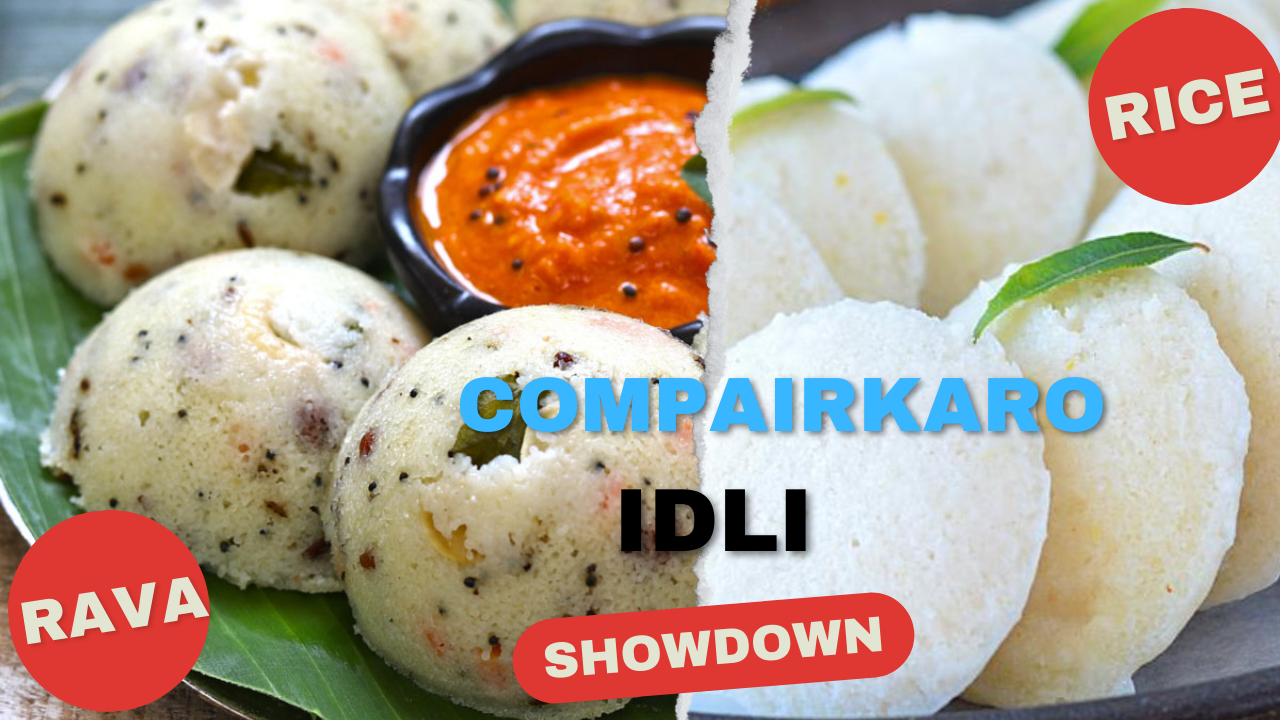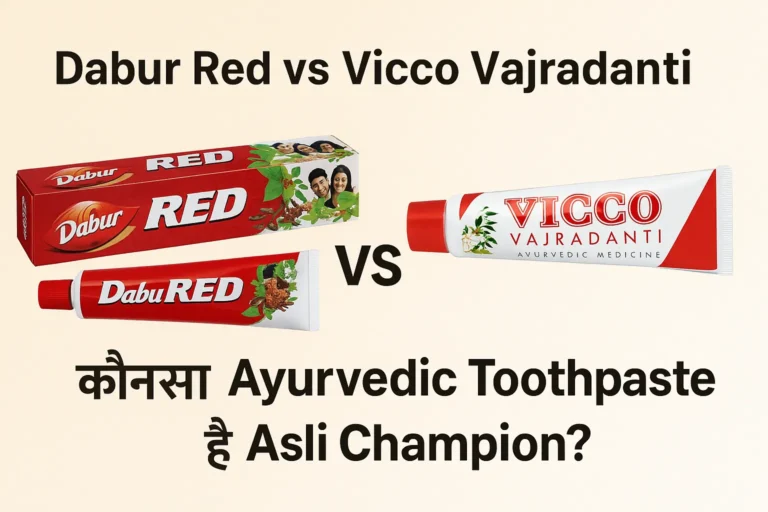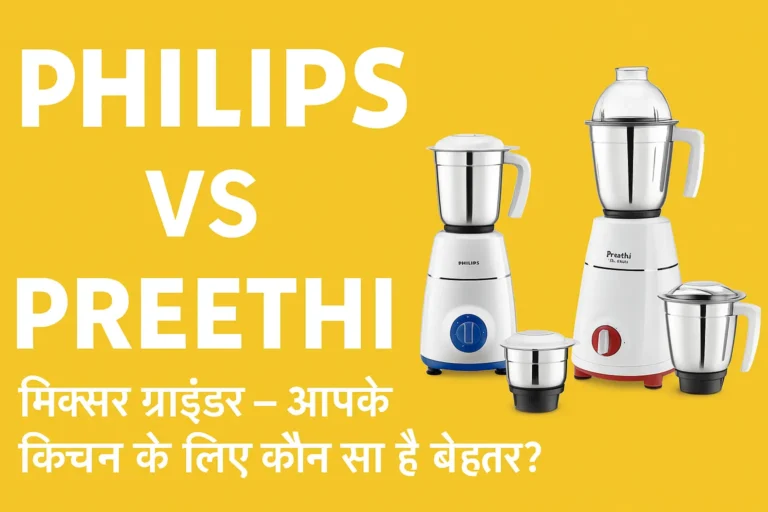Idli, a beloved traditional Indian dish, has gained immense popularity in India and internationally. It is a versatile dish that can be made using a variety of basic ingredients, with rava (semolina) and rice emerging as two prominent options. In this article, we will explore the comparison between Rava Idli and Rice Idli, their unique features, taste and texture. So, let’s embark on this delicious journey and learn the intricacies of these two delicious varieties of Idli.
Let’s Have Some Basic Comparison Among Both :-
1. Ingredients and Preparation of Idli :
Let us explore the main ingredients and process of making Rava Idli and Rice Idli, highlighting the main differences between them.
- Rava Idli: Rava idli is made using rava, also known as semolina, as the primary ingredient. Other essential ingredients include curd, water, oil, mustard seeds, urad dal, chana dal, curry leaves, ginger and baking soda.

- To make Rava Idli, Rava is dry roasted till it turns light golden, which enhances its taste. Then a tempering of curd, water and mustard, urad dal, chana dal, curry leaves and ginger is added to it. Baking soda is added to the batter to aid the fermentation process. The batter is left for a while, allowing the flavors to meld together. It is then cooked in idli molds until cooked well.
- Rice Idli: Rice Idli, on the other hand, mainly uses fermented rice batter as a base. The main ingredients of rice idli include rice (usually idli rice or parboiled rice), urad dal (black gram), fenugreek seeds and salt.
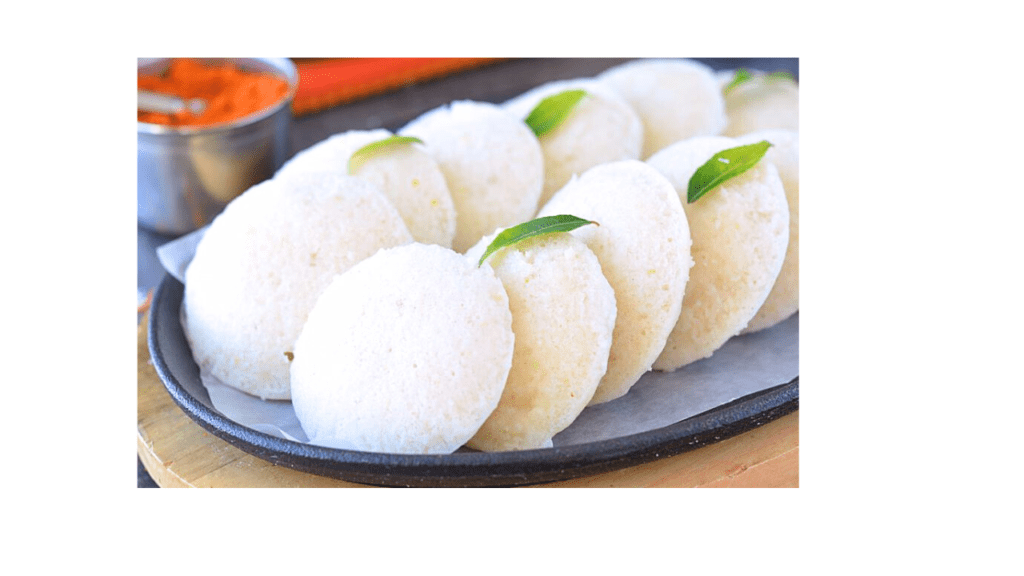
- To make rice idli, rice and urad dal are soaked separately for a few hours. Fenugreek seeds are often added when soaking rice to aid fermentation. After soaking, the rice and urad dal are ground separately to a smooth paste. The two batters are then combined, mixed well, and left to ferment overnight or for several hours. The fermented batter is seasoned with salt and poured into idli moulds, after which the idlis are steamed till they become soft and fluffy.
- Key Difference: The main difference between Rava Idli and Rice Idli lies in the basic ingredients used. Semolina is used in rava idli, while rice idli relies on fermented rice batter. This variation results in contrasting textures and flavours. The texture of rava idlis is slightly grainy, while rice idlis are smooth and soft. The fermentation process also differs, with rava idlis requiring less fermentation time than rice idlis.
2. Texture and consistency:
1. Let us explore the texture and consistency of Rava Idli and Rice Idli, highlighting their unique characteristics.
- Rava Idli: Rava idli has a distinctive texture which can be described as slightly grainy or coarse. The use of semolina (rava) as the main ingredient gives it a grainy feel. adding curd and water to the batter helps in softening the texture during the steaming process. When cooked, the rava idli retains a slight graininess, imparting a pleasant flavor and a slight crunch.
- Rice Idli: Rice Idli on the other hand, boasts of a smoother and softer texture than Rava Idli. The fermentation process, along with the grinding of soaked rice and urad dal, results in a batter that is airy and light. As the idlis steam, they become incredibly soft and tender, almost melting in your mouth. Rice Idli has a delicate and smooth consistency, which makes for a delightful eating experience.
2. Difference in Bite and Mouthfeel: Due to difference in texture and consistency, Rava Idli and Chawal Idli have different bite and mouthfeel.
- Rava idli, with its grainy texture, imparts a slightly strong flavour. The coarse texture of semolina imparts a pleasant chewy flavor, making each bite more distinctive. The crunchy nature of rava idli adds a unique element to the overall taste, striking a balance between softness and texture.
- Rice idli, with its smooth and soft texture, offers a more delicate taste. Idlis practically melt in your mouth, requiring minimal effort to enjoy. The airy and light texture of rice idli contributes to its incredibly soft and fluffy nature, resulting in a smooth and almost creamy taste.
By understanding the difference in texture, taste and mouthfeel between Rava Idli and Rice Idli, we can appreciate the different sensory experiences they provide.
People also Read :- Intense Honey Showdown: Dabur vs Patanjali
3. Taste and Flavor :
Let us find out the difference in taste and flavor between Rava Idli and Rice Idli, highlighting their distinctive features.
- Rava Idli: Rava Idli has a unique taste which can be described as slightly nutty and salty. Semolina (rava) used in its preparation adds a subtle nuttiness to the overall taste. Additionally, a tempering of mustard seeds, urad dal, chana dal, curry leaves and ginger enhances the delicious taste of rava idli. These ingredients imbue the idli with a pleasant aroma and savory taste, adding depth to the overall taste.
- Rice Idli: Rice Idli, on the other hand, offers a more mild and neutral flavor than Rava Idli. The primary focus of rice idli is to highlight the natural flavor of the fermented rice and urad dal batter. As a result, rice idli has a relatively mild flavor which allows it to pair well with a variety of chutneys and sambar. The fermentation process brings out a slight tartness in the flavor, further enhancing the overall flavor profile.
4. Additional Ingredients and Spices :
While the main ingredients of Rava Idli and Rice Idli contribute to their respective flavours, there are also additional ingredients and spices that can be included to enhance the flavor of each variant.
- The tempering process in rava idli often includes ingredients like mustard seeds, urad dal, chana dal, curry leaves and ginger. These ingredients infuse the idli with its distinctive flavor, and complement the nutritional value of the semolina.
- Rice idli, being more neutral in taste, allows a variety of accompaniments to shine. It is usually served with a delicious chutney like coconut chutney, tomato chutney, or mint chutney, which impart rich flavor and freshness. Sambar, a lentil-based vegetable stew with spices, is another popular accompaniment that adds depth and savory notes to the overall taste experience.
By understanding the difference in taste and flavor between Rava Idli and Chawal Idli, we can appreciate the unique and varied culinary experiences they offer.
5. Nutritional Comparison :
Let us compare the nutritional aspects of Rava Idli and Rice Idli, highlighting the differences in calorie content, protein, carbohydrate and other nutrients. We’ll also discuss the potential health benefits and considerations associated with each type.
- Rava Idli: Rava idli is relatively low in calories as compared to rice idli. There are approximately 150-200 calories in a typical serving of Rava Idli (2 Idlis). It is a good source of carbohydrates and provides energy to the body. Rava idli also contains dietary fibre, which aids digestion and contributes to a feeling of satiety. however, the protein content is relatively less as compared to rice idli.
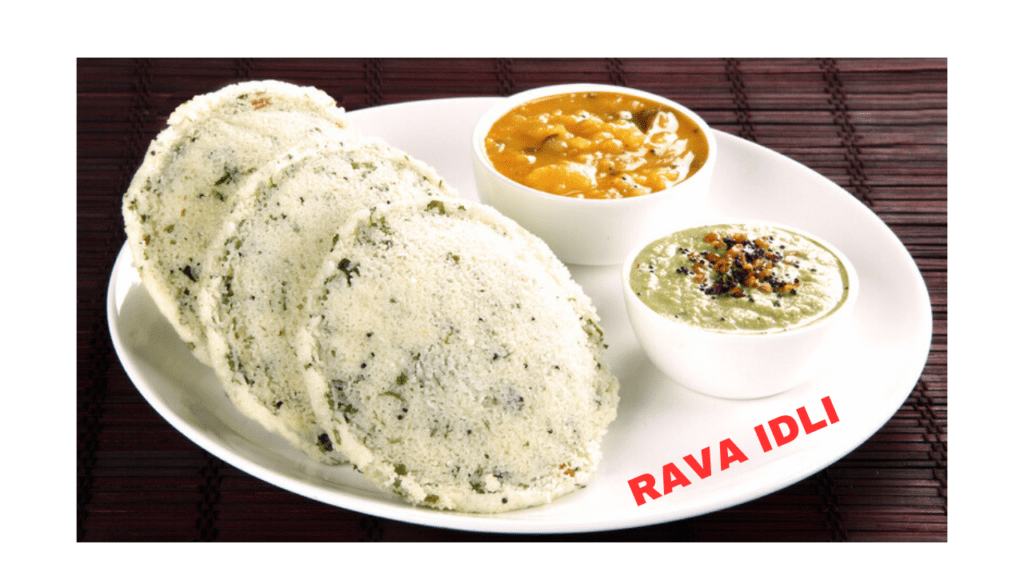
- Rice Idli: Rice Idli is slightly higher in calories as compared to Rava Idli. There are generally around 200-250 calories in one serving of Rice Idli (2 Idlis). Rice idli is also a good source of carbohydrates and provides sustained energy. It also contains small amounts of dietary fiber. Rice idli has more protein than rava idli, thanks to the combination of rice and urad dal used in the batter. Protein is essential for building and repairing tissues, supporting the immune system, and various other bodily functions.
6. Health considerations :
- Both rava idli and rice idli can be part of a healthy diet, but it is important to consider certain factors. Rava Idli can be a better option for individuals who are looking for a low calorie option. Additionally, the use of semolina in Rava Idli provides some essential nutrients including iron and B-vitamins.
- On the other hand, rice idli, with its high protein content, may be beneficial for individuals looking to increase their protein intake, especially those following a vegetarian or vegan diet. The fermentation process involved in making rice idlis also increases the bioavailability of certain nutrients and promotes gut health.
- When considering the health benefits and considerations, it is important to focus on portion size and the overall balance of the food. Both types of idli usually have a low fat content and can be complemented with a variety of nutritious side dishes such as sambar, chutney and sabzi to enhance the overall nutritional value.
Remember, individual nutritional needs may vary, so it is recommended to consult with a healthcare professional or registered dietitian for personalized dietary guidance based on your specific needs.
By comparing the nutritional aspects of Rava Idli and Rice Idli, we can make an informed choice that suits our dietary goals and preferences.
7. Suitability for Special Diets :
Let us discuss the suitability of Rava Idli and Chawal Idli for special dietary needs, considering factors such as gluten-free, vegetarian and specific dietary restrictions. This information will be helpful to readers with dietary preferences or restrictions.
- Gluten-free idea: Rava idli can be a suitable option for individuals following a gluten-free diet. Semolina, the main ingredient in rava idli, does not naturally contain gluten. However, it is important to ensure that other ingredients used in the tempering and chutney or accompaniment are also gluten-free to maintain overall suitability.
- Vegetarian Ideas: Both Rava Idli and Rice Idli can be suitable for a vegetarian diet with some adjustments. In rava idli, the traditional tempering often includes ingredients like mustard seeds, urad dal and chana dal, which are plant-based. However, it is essential to check that these ingredients are not prepared from any animal-derived products like ghee (clarified butter). Similarly, when making rice idlis, it is important to use plant-based alternatives to any ingredients that may traditionally be derived from animal products such as ghee or yogurt.
- Dietary Restrictions: Rava Idli and Rice Idli can be versatile enough to accommodate specific dietary restrictions. For individuals with lactose intolerance or dairy allergies, they can be prepared without the use of yogurt or other dairy-based ingredients. The fermentation process in rice idlis can help improve digestibility and reduce potential digestive problems associated with consuming plain rice.
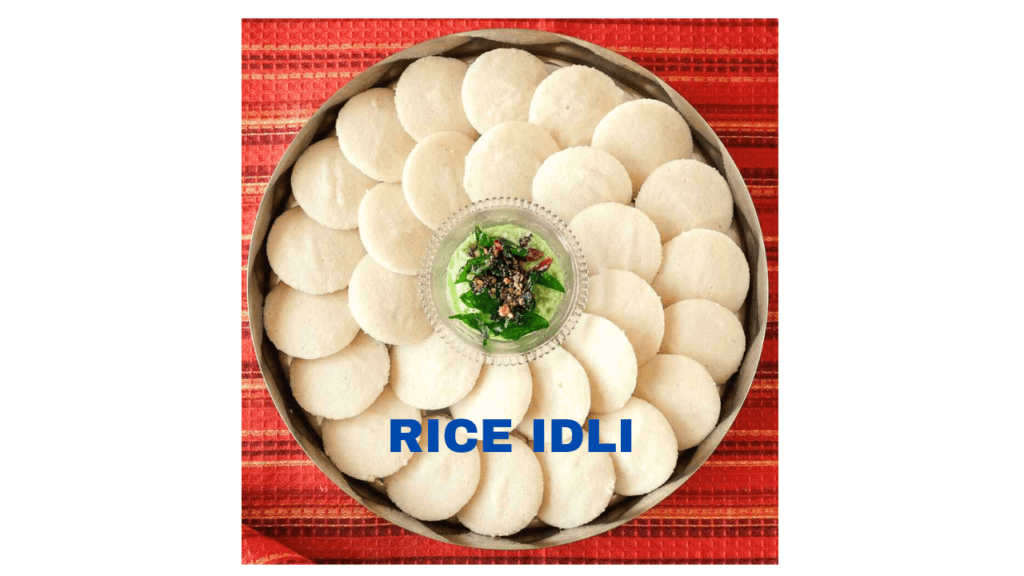
It is important to note that while Rava Idli and Rice Idli may be suitable for specific dietary needs, it is necessary to choose and prepare ingredients carefully to ensure that they meet individual requirements. Additionally, when consuming idlis in restaurants or other establishments, it is advisable to inquire about the specific ingredients used to ensure that they align with dietary preferences or restrictions.
By considering the suitability of Rava Idli and Chawal Idli for special diets, individuals with specific dietary requirements can make informed choices and enjoy these delicious delicacies within the parameters of their dietary restrictions or preferences.
8. Regional Variations :
Let us explore the regional variations and preferences associated with Rava Idli and Chawal Idli, consider whether one type is preferred over the other in certain regions or communities and explain the reasons behind these preferences Is.
- South Indian cuisine: Rava idli and rice idli are both popular in South Indian cuisine, but there are regional variations in their preferences. In the southern Indian states of Karnataka and Andhra Pradesh, rava idli is often preferred over rice idli. The use of semolina in Rava Idli imparts a distinctive texture and flavor that is preferred in these regions. rava idli is known for its quick preparation time and ability to provide a satisfying breakfast or snack option.
- On the other hand, rice idli has a strong presence in Tamil Nadu and Kerala, where it is a staple of traditional South Indian cuisine. Rice idli is prized for its soft and fluffy texture, which is achieved through fermentation of a batter of rice and urad dal. The popularity of rice idli in these regions can be attributed to cultural preferences and availability of ingredients.
- Reasons for preferences: Regional preferences for rava idli and rice idli can be influenced by various factors including local customs, taste preferences and availability of ingredients.
- The preference for rava idli in Karnataka and Andhra Pradesh may derive from the culinary traditions of the region as well as the influence of local ingredients. Semolina (rava) is commonly used in various dishes in these regions, making rava idli a natural choice. Additionally, the convenience of rava idli’s short fermentation time may also contribute to its popularity.
- In Tamil Nadu and Kerala, the popularity of rice idli can be attributed to the availability of rice and urad dal, which are staple ingredients in these regions. The tradition of fermenting rice and urad dal to make idli is passed down through generations, giving preference to rice idli.
It is important to note that although these regional preferences exist, Rava Idli and Chawal Idli are enjoyed throughout South India and beyond. With ease of transportation and cultural exchange, both types of idli have become popular in different regions, providing a wide variety of options for idli connoisseurs.
By understanding the regional variations and preferences of Rava Idli and Chawal Idli, we gain insight into the cultural nuances and culinary traditions associated with these delightful South Indian delicacies.
9. Serving and Accompaniment :
Let us look at some suggestions for serving Rava Idli and Chawal Idli with traditional accompaniments that go well with each variant. We’ll also mention any typical serving style or presentation associated with these idlis.
- Rava Idli: Rava idli is often served with a variety of flavourful chutneys and sambar. Here are some popular associations:
- Coconut Chutney: A classic accompaniment to rava idli, coconut chutney is made with fresh coconut, roasted chana dal, green chillies and mustard seeds and a tempering (tempering) of curry leaves. It adds a creamy and refreshing element to idlis.
2. Tomato Chutney: This hot and spicy chutney is made from tomatoes, onions, red chillies and other spices. It imparts a tangy flavor which complements the delicious taste of Rava Idli.
3. Sambar: A lentil-based vegetable stew with a medley of spices, sambar is a main accompaniment to idli. It adds a savory and tangy element that blends well with the slightly nutty flavor of Rava Idli. Adding vegetables like drumstick, carrots and eggplant enhances the overall flavor.
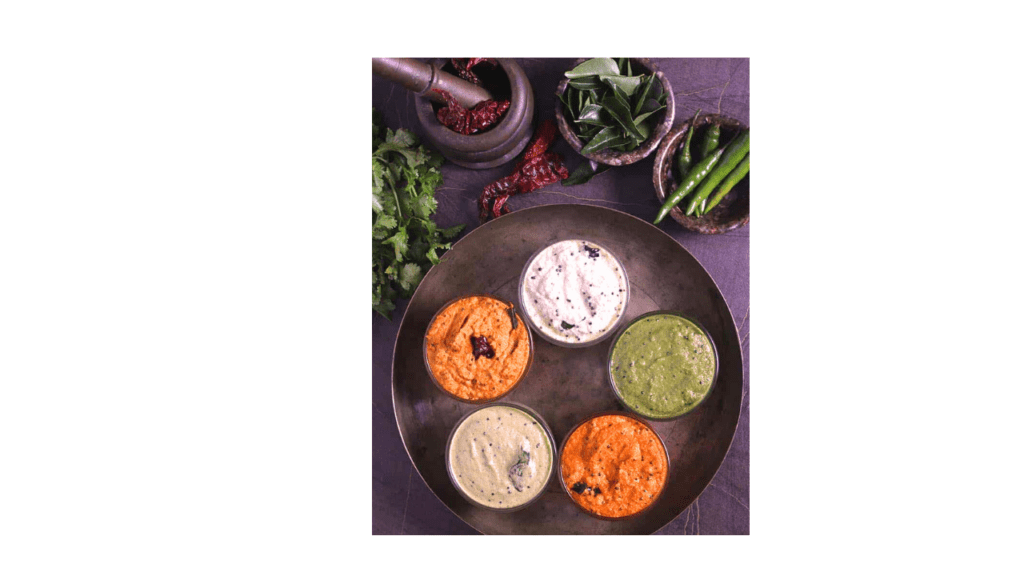
- Rice Idli: Rice idli is traditionally served with a variety of accompaniments that enhance its delicate taste. Here are some popular options:
- Coconut Chutney: Like Rava Idli, coconut chutney is a versatile accompaniment to rice idli as well. Its creamy texture and mild coconut flavor complement the soft and fluffy nature of the idli.
2. Tomato Chutney: The spiciness of tomato chutney adds a vibrant flavor to the rice idli, balancing its mild flavor. It can be prepared with a mixture of tomatoes, onions and spices.
3. Sambar: Like Rava Idli, rice idli goes exceptionally well with sambar. The savory lentil and vegetable stew provides a satisfyingly savory element that complements the subtle flavor of the rice idli.
- Serving Styles: Rava idli and rice idli are usually served after being cooked in idli moulds, resulting in a round and puffy shape. They can be enjoyed as a stand-alone dish or served as part of a complete meal. Idli is often served on a plate or banana leaf, with chutney and sambar in small bowls or serving dishes.
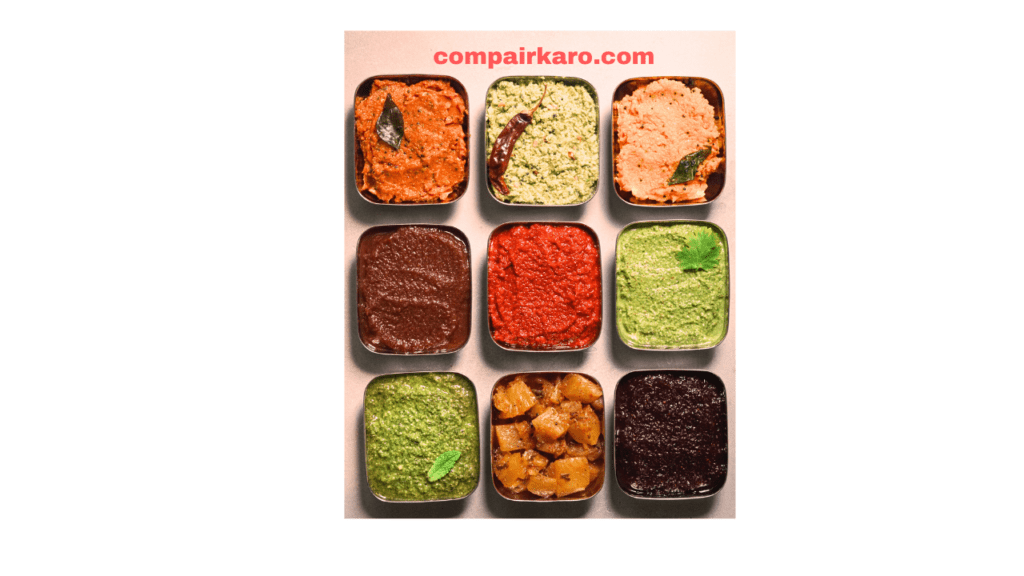
Remember, these are just conventional suggestions, and you can experiment with different accompaniments and flavorings based on your own preferences and creativity. Its versatility allows for endless possibilities when it comes to serving and enjoying idlis.
By considering the suggested accompaniments and serving styles for Rava Idli and Chawal Idli, you can create a delightful dining experience that celebrates the flavors and textures of these beloved South Indian dishes.
10. Personal Preferences and Recommendations :
- Taste and texture preference: Consider your personal taste preferences when choosing between Rava Idli and Rice Idli. If you enjoy a slightly nutty and salty taste with a grainy texture, then rava idli can be a great option. On the other hand, if you prefer soft, smooth idlis with a mild flavour, then rice idlis would be a great option.
- Consider the occasion: Think about the occasion or meal for which you are planning to serve idlis. The slightly firm texture and nutty taste of rava idli can make it a suitable option for breakfast or snack. The soft and delicate nature of rice idli makes it an excellent option for a light lunch or dinner.
- Experiment with accompaniments: Don’t be afraid to experiment with different chutneys, sambar variations, or other side dishes to find your favorite combination. The beauty of idlis lies in their versatility, which allows you to explore different flavors and textures to suit your taste buds.
- Customize the batter: Feel free to add your own twist to the idli batter by adding additional ingredients like grated vegetables, chopped herbs, or spices. It can add extra flavour, nutrition and visual appeal to your idlis.
- Try Fusion Variations: Consider experimenting with fusion variations of idlis by incorporating ingredients or flavors from other cuisines. For example, you can add grated cheese and herbs to the batter for a fusion twist or explore mixing different spices for a unique flavor profile.
- Explore Steaming Techniques: Explore different steaming techniques and tools to achieve your desired texture. Traditional idli molds work well, but you can also use silicone molds or try steaming in small bowls or ramekins.
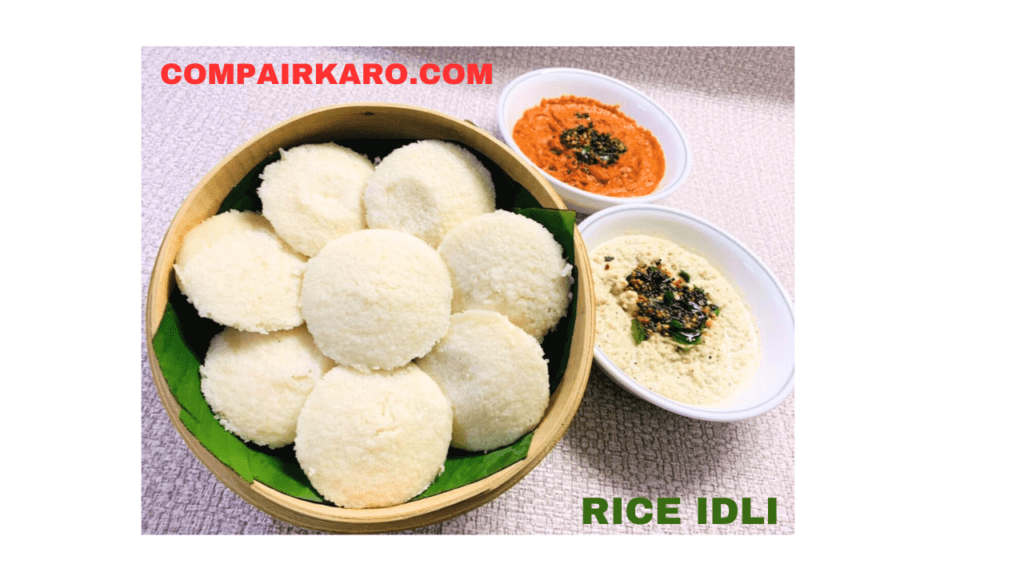
- Plan ahead for fermentation: If you choose to make rice idlis, keep in mind that the fermentation process takes time. Plan on soaking the rice and urad dal overnight or for several hours to ensure a well-fermented batter.
Remember, everyone has different taste preferences, so it is always a good idea to try both Rava Idli and Chawal Idli to find your favourite. Feel free to be creative, adapt the recipes to your liking and enjoy exploring the world of idlis in your own kitchen.
Conclusion :
In conclusion, we have explored the key points surrounding Rava Idli and Rice Idli, understanding their differences in texture, taste, nutrition and regional preferences. Rava idli offers a slightly grainy texture and nutty, savory flavour, while rice idli offers a soft, fluffy texture with a mild flavour.
Both the types of idli have their own unique charm and can be enjoyed in different ways. Rava idli’s quick preparation time and distinctive flavor make it a popular choice in some regions, while rice idli’s traditional fermentation process and delicate nature hold a special place in South Indian cuisine.
We encourage readers to try both Rava Idli and Rice Idli to truly appreciate their distinctive features. Experiment with different accompaniments, flavors and presentations to find your personal preference. Each type of idli offers a delightful culinary experience that can be enjoyed for breakfast, as a snack, or as part of a complete meal.
Remember, the beauty of exploring the world of idlis lies in discovering the unique flavours, textures and cultural nuances associated with these beloved South Indian delicacies. So, don’t hesitate to embark on your own idli adventure and enjoy the delights they bring to your taste buds.

